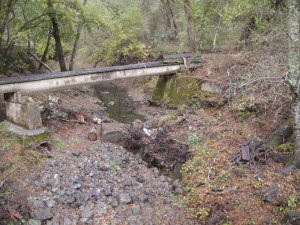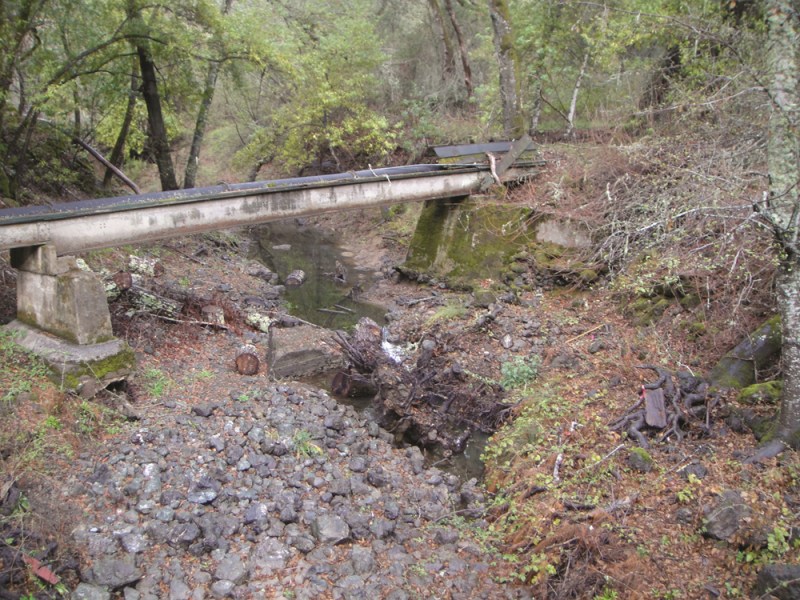After a Feb. 28 court-ordered inspection of the Jasper Ridge Biological Preserve, two environmental groups filed a lawsuit on Mar. 11 against the National Marine Fisheries Service (NMFS) for allegedly allowing Stanford University to endanger steelhead trout.

The lawsuit refers to two of Stanford’s water diversions downstream of the Searsville Dam that provide irrigation for a golf course and other campus landscaping. Our Children’s Earth Foundation and the Ecological Rights Foundation had previously sued Stanford in Jan. 2013, in a lawsuit that is currently in the discovery phase. Both foundations are part of a network of Northern California environmental groups.
“In recent years [we] have gotten increasingly interested in endangered species protection,” said Christopher Sproul, lead attorney for the plaintiffs and a member of both organizations. “Steelhead and endangered species like that are the canaries in the coal mine. If water quality and environmental quality are not being maintained, they’re kind of the first to really see effects.”
The allegations
According to Sproul, the Searsville Dam blocks the flow of water that steelhead trout need, thus harming the fish and violating the Endangered Species Act.
“We’ve claimed that Searsville Dam and Searsville Reservoir have the effect of doing substantial damage to the shape and composition of the creek bed below Searsville Dam in a way that renders it less suitable for steelhead,” Sproul said. “We were taking measurements to confirm that, and we did [confirm that effect].”
In its current state, the creek bed consists of mostly jagged rock, lacking the gravel that steelhead use for spawning. Sproul also explained that the trout were spawning at the time of the inspection and that adult steelhead are currently present in the San Francisco Bay.
In addition to the lack of good breeding terrain in the lower section of San Francisquito Creek, the Searsville Dam also prevents sufficient freshwater from reaching the bay. The fish sense the presence of freshwater, which signals them to swim upstream to spawn.
“By blocking the flow in Corte Madero Creek, Stanford is reducing that [freshwater] clue and making it less likely that there’s going to be healthy return of steelhead this year in the San Francisquito Creek,” Sproul said.
However, the organizations did not find any sediment pollution during their inspections, which they claimed was probably due to the dry weather. Flushing sediment into the creek only occurs when the reservoir is full. The claim that Stanford was violating the Clean Water Act is still under investigation.
“When Stanford is actively pumping water out of the reservoir, the pipelines tend to get clogged with sediment, and then they flush the sediment out into the creek,” Sproul said. “That’s in Stanford’s own documents.”
Stanford’s response
Although the organizations’ inspection tour was led by Jasper Ridge biologists, Sproul said that the Stanford scientists did not comment on the state of the watershed during their tour.
Bradley Hayward ’92, Stanford’s senior director of strategic communications, provided a written statement regarding the litigation.
“The filing of a lawsuit does not mean that the allegations are true,” Hayward wrote. “The National Marine Fisheries Service conducted a thorough evaluation and issued permits for Stanford that do not harm and in fact benefit the fish in Los Trancos Creek and the San Francisquito watershed.”
Hayward also explained that the University has constructed a fish ladder to facilitate steelhead migration up Los Trancos Creek, one of the San Francisquito Creek’s tributaries. NMFS approved the construction of this ladder and Stanford’s proposed water diversions in 2008.
“It was the result of a multi-year [sic] process involving careful analysis and evaluation of the project,” Hayward said. “Specific minimum flows in the creek are required by NMFS, for the benefit of steelhead, before Stanford can divert water. Upstream migration is not blocked, and in fact the Steelhead Enhancement Project (SHEP) created more effective upstream migration.”
“The University is committed to conserving habitats for protected species and is in full compliance with the Endangered Species Act and all local, state and federal laws in its operations of Searsville Dam and Reservoir,” Hayward wrote.
The future of Searsville Dam and the steelhead trout
To further investigate possible long-term futures for the dam, Stanford faculty members are continuing their research on the reservoir. The University has also established the Searsville Alternatives Study, which has a steering committee that recommends actions for the reservoir that best meet a balance of University objectives.
American Rivers is an organization dedicated to protecting the nation’s rivers and is currently a member of the advisory group for the Searsville Alternatives Study.
According to Steve Rothert, director of the California office of American Rivers, options to help the endangered fish include providing the steelhead with access to spawning habitat upstream of the dam, allowing water passage through the dam during dry summer months and planting vegetation to stabilize the creek’s banks downstream.
“There is approximately 20 miles of historic habitat that is considered in good condition upstream of the dam that they can’t now get to,” Rothert said.
However, Rothert also explained that since San Francisquito Creek acts as a boundary between San Mateo County and Santa Clara County, the creek has actually remained in relatively good condition. According to Rothert, many other Bay Area streams have been layered with concrete to serve as flood channels.
According to Rothert, although American Rivers was asked to join Our Children’s Earth Foundation and the Ecological Rights Foundation as a co-litigant, the organization declined to join the lawsuit against Stanford.
“American Rivers is an active member of the advisory group that is an official part of Stanford’s Searsville Alternatives Study process,” Rothert said. “The Searsville Alternative Study process was getting underway, and we wanted to remain active and constructive in that process and not be distracted by litigation.”
Rothert suggested that the water resources the dam provides could be replaced entirely by Stanford’s already existing downstream diversions. He applauded the University’s efforts to further investigate other water supply options through the Searsville Alternatives Study.
Associate Professor of Civil and Environmental Engineering David Freyberg M.S. ’77 Ph.D. ’81 has been involved in research at Jasper Ridge for many years, serving on both the Jasper Ridge Advisory Committee and the Searsville Alternatives Study group.
Freyberg explained that researchers are currently gathering information about the many potential outcomes for the dam, and the formal analysis of alternatives has been ongoing for over a year.
“There are a number of different ways that fish can get by a dam,” Freyberg said. “The most common scenario is to construct an artificial channel that goes around the dam. It has to…be at a flat enough slope so the fish can swim up.”
However, Freyberg explained that the solutions are not one-sided. Installing a passage for fish around the dam would require controlling the water flow at all times to prevent floods. Sediment has accumulated behind the dam, complicating any effort to remove the dam entirely.
“There are three regions in which we need to understand the impacts of change: flow of water and sediment and the consequences for both people and other organisms,” Freyberg said.
Although no firm deadline for finding a solution has been set, researchers hope to determine a promising option soon.
“The committee has been charged with reporting to the administration…either late this year [or] early next year,” Freyberg said.
“I certainly don’t have a clear idea of how all the tradeoffs are going to play out, and so I think we have a ways to go before it will be clearer what alternatives are the most viable,” he added. “It’s still an open question.”
Where the lawsuit will go
Sproul explained that although settlement has been discussed, the parties have not reached an agreement. If no informal resolution can be reached, the next step will be to ask a judge to issue a decision in the case.
“We’ve had settlement discussions with Stanford, but we didn’t get anywhere,” Sproul said. “We would like to settle if we can get something reasonable for the fish, but so far in our view, Stanford is not being reasonable.”
Professor of Environmental Law and Director of the Environmental Law Clinic Deborah Sivas J.D. ’87, who represented the organization Spawn in a similar litigation against Marin County, shared her perspective on the Searsville Dam case.
“If the plaintiffs were successful and the court found that they were correct, the court would typically order [Stanford] to go seek a permit,” Sivas said. “It gets a little tricky; it goes back to the agency to determine if a permit was appropriate. The agency would then have to determine if the species is truly endangered.”
Sivas believed it would be unlikely for Stanford to be required to tear down Searsville Dam. She explained that foothill erosion has created a new marsh-like ecosystem due to the buildup of silt at the base of the dam. Removing it would negatively affect Jasper Ridge wildlife, she said.
“The NMFS typically wouldn’t make anyone take down the dam,” Sivas said. “More likely the NMFS would make Stanford cut back on water to be taken out of the dam or figure out a way to allow fish to move beyond the dam.”
Sivas predicted that the parties will settle and that the case is not likely to go to trial.
“Courts have not been that receptive to these cases,” Sivas said. “Some have been able to win, but I don’t know [the organizations’] evidence on harm to the species…I suspect this case will not go to trial, but I suspect there will be a potential settlement.”
Sproul spoke about what Our Children’s Earth and the Ecological Rights Foundation want to see from the lawsuit.
“In the short term, we’d like to see Stanford stop diverting water out of the local creeks or at least substantially cut back diversion,” Sproul said. “We would like to see Stanford do some habitat restoration.”
In the long term, the organizations want the University to provide the trout with a path around Searsville Dam, regardless of whether that involves constructing a passage through or around the dam or removing it all together.
“We’re still continuing to do discovery, to get as much information as we can,” Sproul said. “In the near future, we’ll be bringing motions to try to get some relief for the fish.”
Contact Kylie Jue at kyliej ‘at’ Stanford ‘dot’ edu.
